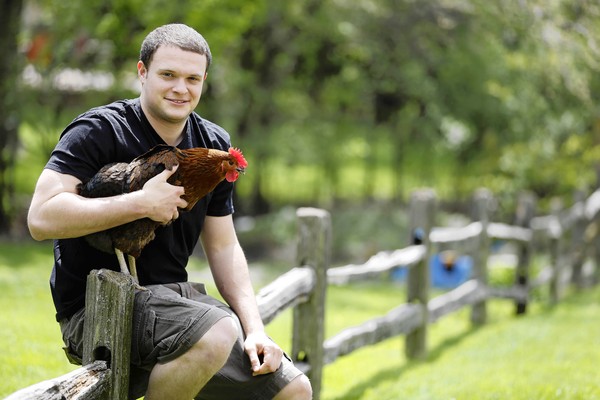Antibiotics in livestock raising concerns up the food chain
Citing danger to humans, health groups challenge widespread use; FDA resisting demands for change
Chicago Tribune
May 26, 2013|By Monica Eng, Chicago Tribune reporter
While Sam Spitz’s friends were loading up on pizza for lunch, the Whitney Young High School sophomore opted for a chicken Caesar salad. 
Spitz was in training for a big sophomore baseball season — after having pitched on the school’s varsity team as a freshman — so, he says, he “wanted to make the healthy choice.”
But soon he was not so sure he’d chosen wisely. Severe gastric distress kept him in the bathroom for hours, and eventually he started losing blood.
After multiple trips to the emergency room, Spitz learned he’d been infected with an antibiotic-resistant strain of campylobacter, a pathogen most commonly linked to poultry. He blames the salad, as the chicken Caesar was his only source of poultry that week.
One month, 30 pounds and several failed antibiotics later, Spitz had lost his baseball season along with much of his confidence. He’d also lost a lot of faith in the “miracle drug” of the 20th century, antibiotics.
“I was 15 and I never pitched in high school again,” said Spitz, now 22. “I’d spent that entire offseason training, and I was stronger than I’d ever been. I thought I was invincible, but I watched myself and my baseball career wither away. … I thought antibiotics were supposed to work. But they didn’t and that was terrifying.”
Concern has been intensifying in recent years over the use of antibiotics in agriculture, which world health authorities agree contributes to the development of drug-resistant bacteria. These so-called superbugs infect hundreds of thousands and kill tens of thousands of Americans each year, according to the Centers for Disease Control and Prevention.
Legislation before Congress would rein in the use of medically important antibiotics on healthy livestock through mandatory restrictions as well as public disclosure of how antibiotics are used on animals and in what quantity.
But such efforts face resistance from the meat industry, and the U.S. Food and Drug Administration says the issue is better handled through voluntary guidelines it hopes to finalize this year, including more veterinary oversight.
Critics doubt that a voluntary approach would decrease use and say the current lack of transparency would prevent anyone from knowing whether it did — an issue also noted by the Government Accountability Office.
Health authorities say antibiotics should be used sparingly because any bacteria that can survive the drugs will multiply, increasing the strain’s overall resistance. Dr. Jean Patel, deputy director of the Office of Antimicrobial Resistance at the CDC, calls antibiotic resistance one of the nation’s most serious health threats.
“Resistance often emerges in the health care setting where antimicrobials are commonly used,” Patel said, “but these drugs are also used on the farm, and a number of foodborne pathogens, like salmonella, are becoming increasingly resistant to antimicrobials that are important for human health.”
The Environmental Working Group, a research and advocacy group, analyzed government data and reported last month that 69 percent of pork chops and 81 percent of ground turkey sampled in 2011 were contaminated with antibiotic-resistant bacteria. Turkey raised without antibiotics — including organic turkey — carries fewer such pathogens, according to recent research by Consumers Union, the advocacy arm of Consumer Reports.
About 80 percent of all antibiotics sold by weight in the U.S. in 2011 were used on livestock, according to FDA figures. That year, 7.3 million pounds of antibiotics were used to treat humans, compared with 29.9 million pounds sold for meat and poultry production.
All parties in the antibiotics debate agree that it makes sense to treat sick animals with appropriate antibiotics. And nearly all say that using antibiotics just to make animals grow faster — a practice long banned in the European Union — is, as the FDA puts it, “injudicious.”
If the FDA’s voluntary guidance is finalized this year, livestock producers will be asked to stop using antibiotics solely to fuel growth starting sometime in 2016. Antibiotics still could be given to animals to control and prevent disease, but licensed veterinarians would oversee the process.
Critics say the strategy is too weak. Noting that many antibiotics are marketed for growth promotion as well as disease prevention, environmental and consumer groups fear that animals will remain on a steady diet of antibiotics, if for different stated reasons.
“The first problem is that it is voluntary. As far as we are concerned the FDA has tried a voluntary approach on this for almost 40 years, and it hasn’t worked,” said Avinash Kar, an attorney who works on antibiotic issues for the Natural Resources Defense Council, an environmental advocacy group. “The second problem is that it leaves a giant loophole for so-called preventive uses.”